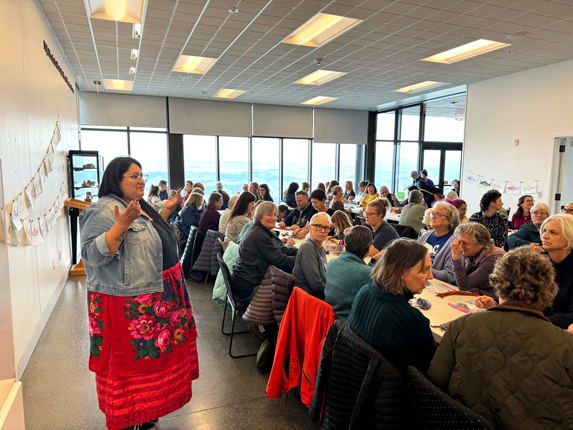
With a view of the Columbia River, a basket weaving class helps heal
Listen
(Runtime 4:01)
Read
When Chestina Dominguez was little, her maternal grandmother, her kuthla, wanted to teach her to weave.
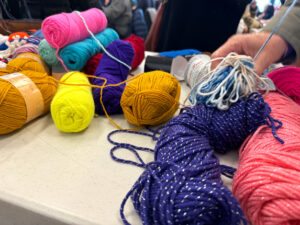
Students selected from colorful yarn as they entered the wa’paas class. They cut at least four arm spans of yarn for each tiny basket. (Credit: Courtney Flatt / NWPB)
“I never wanted to learn. I always wanted to go play out in the ditch and run around in the country. But she taught me those basics,” Dominguez said.
Dominguez is an enrolled Yakama Nation member and a descendant of the Warm Springs Tribe. Years later, Dominguez was in recovery, learning to be sober. She returned to her kuthla’s traditional teachings.
“So I learned how to root, go out and gather roots and berries, how to make jam, how to preserve our foods and how to weave,” she said.
That was nearly 13 years ago. Now, she’s bringing her lessons to would-be weavers at Maryhill Museum of Art, near Goldendale, Washington. Dominguez works with the Yakama Nation Behavioral Health Services.
“Weaving teaches you patience and perseverance and all those little things, to be mindful,” Dominguez said.
She would need those skills on Saturday, during her last in-person class of the season.
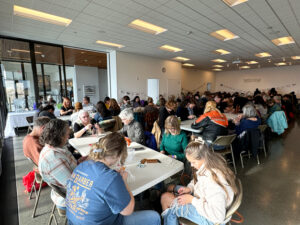
The wa’paas weaving class was packed on Saturday with more than 100 students. Typically, it has maxed out at 60 students. This was the last in-person class of the season. (Credit: Courtney Flatt / NWPB)
More than 100 people, traveling from Yakima to Portland to Spokane, packed into the wa’paas class, after an article in The Oregonian made the popular functional basketry classes even more so. Typically, the classes maxed out at 60 people.
The wa’paas class is grant-funded, allowing students to attend for free and paying for Dominguez’s travel and supplies.
Attendees pulled in tables and chairs. Some worked in the hallway.
The line to pick out yarn flowed out of the room. Dominguez’s mother, Sonya, helped weavers get the right amount of yarn, about four arm spans.
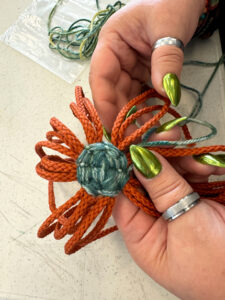
Angel Miller, an employee at the Maryhill Museum of Art’s cafe, works on the bottom of her basket at the wa’paas class. (Credit: Courtney Flatt / NWPB)
“Grab the yearn. You just pick out one, and let me show you,” Sonya said, as she started to count arm span lengths. “One, and two. Continuously. Four times. Then, you cut it.”
A table was covered in piles of brightly colored yarn to pick from. Weavers scanned the yarn, some picking out neon colors. Some of them picked out mustard yellow, while others went for turquoise.
Supplies in hand, people in seats, Dominguez kicked off the class.
“So when we gather today, this is called community self-care, and we’re helping each other take care of each other,” Dominguez told the class. “But today, if we could just have a lot of patience for ourselves, for me, there’s only me.”
Her biggest piece of advice? Get out of your own head.
“If we get frustrated, just put it down. Take a deep breath,” she said.
That can be a hard rule to follow, she said, especially as a “recovering perfectionist.”
“I always tell people at the beginning, don’t think, just do,” Dominguez said. “Because when we start overthinking, that’s where we get tripped up on, and we just need to be in the moment. And don’t look at your neighbor’s hands. Don’t look at her hands, his hands, their hands. Don’t look at them.”
Dominguez picked up an example group of 12 cords, each with a much larger weight than the yarn. This cordage would form the structure of the baskets.
Perhaps harder for the few men in the room, she explained the weaving technique of wrapping the colorful yarn around the cords as similar to wrapping a ponytail holder around your hair.
“The teaching that was taught to me is if your thumb is coming out and that’s most comfortable, you’re sharing your light and love with others. If your finger is most comfortable coming in, you’re bringing in the light and love. And sometimes I have weavers that do both, and they’re just lovable people,” she said.
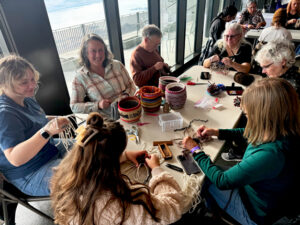
Rachell Lindley, center, began basket weaving at the final class of the 2023 season, right before entering cancer treatment. She said weaving helped her mentally and physically as she recovered. (Credit: Courtney Flatt / NWPB)
This time last year, Rachell Lindley was about to enter cancer treatment. She and her family attended the same weaving class, meant to help heal, shortly before her surgery.
“It was really relaxing. It was really enjoyable. It felt right. We went straight to Joann Fabrics and bought stuff, and I kind of didn’t stop after that,” Lindley said.
Lindley has woven at least 40 intricate baskets during her recovery, multi-colored stripes, pink diamond patterns, condors with their wings spread — her favorite.
“I kind of just used it for mind healing. To give me something to just kind of think about instead of the worry or the stress. And I think also it helped even in a physical therapy sort of way, to be using my arms, keeping me mobile when I had to sit still,” she said.
Lindley said she often gives away her baskets. That’s an important teaching, Dominguez explained: You should give away your first basket.
Sorcha Meek Paul is the museum’s curator of education. She’s woven a bit herself, during the first classes last fall. She said there’s something to the mindfulness in working on this meditative task.
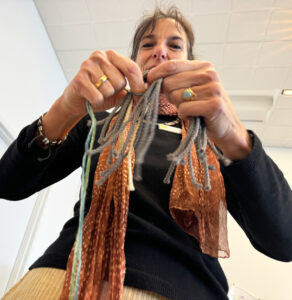
Sorcha Meek Paul, the museum’s curator of education, gathers together cord to form the woven basket’s structure. Meek Paul said weaving can be mindful and meditative. (Credit: Courtney Flatt / NWPB)
“If you have something that’s a consistency, something that you can count on, that’s a really great way to endure a lot of difficult things that can happen,” Meek Paul said.
It’s fun to watch strangers helping each other and the multiple generations weaving together, she said.
Weaver Sherry Phillips, who is a citizen of the Paiute Tribe in Nevada, was taught how to weave pine needle baskets by her grandmother.
“Grandmother would tell us to always put good thoughts into your baskets,” she said. “Be kind to your basket. Everything goes into your basket. That’s one of the most important things, I think. Don’t talk about anything negative.”
With this basket, she said she thought about healing energy for her mother, who’s been sick recently. Now, she said, she’s learning about tribal traditions in the Northwest.
Here, Dominguez said she felt grounded, weaving with a view of the Columbia River.
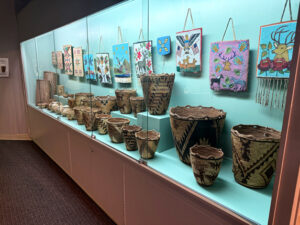
Woven baskets on display at the Maryhill Museum of Art’s Indigenous Peoples of North America exhibit. (Credit: Courtney Flatt / NWPB)
“I feel like my ancestors were right here, weaving on the banks of the river, trading,” Dominguez said.
And then she thinks about her kuthla, her maternal grandmother.
“I lost my grandma when I was a young woman, and so I feel like I missed the opportunity to actually sit and weave with her as an adult,” she said.
One class, someone told her: Everytime you weave, she’s here with you. Tears flowed.
“It just hit me a lot harder and was like, ‘OK, every time I’m doing this, she’s with me.’ It was powerful,” she said.
Dominguez conveyed those emotions to everyone in class, telling one student a friend was with her as well.
The classes have become so popular, the museum hopes to host online classes this winter.
UPDATE: Maryhill Museum of Art will continue in-person weaving classes in March 2025.















